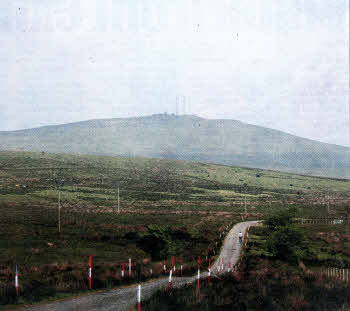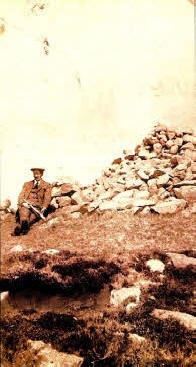
Discovery, dames and dodging gamekeepers on Divis
THE DIGGER

"When summer decked sweet Coffin glen
And made old Divis smile,
'Twas heav'n on earth to meet her then
By Aughrim's ivied pile."
A verse taken from a poem titled 'Annie dear' penned by the 19th century school teacher Henry McDonald Flecher. Divis was one of the local beauty spots that he referred to in several of his poems.
In Flecher's time the height of Divis was recorded as 1567 feet above sea level, and it would have been a familiar site to him as he worked in his first placement in his career at Hannahstown National School.
In the early 19th century it was not unusual to see Divis spelt in local publications as 'Devis'.
Divis would attract people and organisations from all parts and walks of life.
In July 1829 the Belfast Newsletter reported that members of the Natural History Society of Belfast stationed themselves for 24 hours on the summit of the mountain. It appeared this was part of an internationally organised observation of the night sky.
Divis was also the focal point for Lieutenant Thomas Drummond's "limelight." It was used in the early 19th century for ordnance survey mapping.
In 1833 it was reported that a light produced by the oxyhydrogen limelight, on a mountain 200 feet above sea level, close to Londonderry, was "distinctly seen from the Devishill near Belfast," a distance of 66 miles.
 There have been a few amusing and noteworthy tales emanating from the
area.
There have been a few amusing and noteworthy tales emanating from the
area.
There were those throughout the course of history who sought refuge in the Belfast hills.
In June 1798 it was reported in the Belfast newsletter that James Dickey, described as an attorney from Crumlin, had been located by the Sutherland Fencibles "skulking in a bog near Devis Mountain."
He was a United Irishman and subsequently tried for treason and rebellion, found guilty and hanged.
Divis attracted many visitors to its summit in Victorian times. Many would enjoy the magnificent views of the surrounding country.
There were other attractions linked to the mountain in those times and one man believed to be about 60 in 1856 succumbed to the affections of a young lady residing in the vicinity. It was reported that the gentleman was due to be married when "an unlooked-for circumstance" prevented it. A member of her family had visited Belfast and called at his home address to discover that he was already married, living with his wife and had a grown up family!
Other forms of "hide and seek" were commonplace on Divis and the surrounding area. The participants were the gamekeeper and the poacher.
On one occasion in 1887 there had been a dispute between several employees of Lord Templeton who was a landowner. It was alleged that his gamekeeper, James Marshall and his assistant, James Robertson had fired into the home of another employee John Boyd.
At the time John Boyd lived with his wife, Fanny, and six children on the mountain. Several months later James Marshall alleged that he had been fired upon by a poacher who he gave chase to on Divis after he had observed two men digging a rabbit hole. The defendant in the case was later acquitted.
In October 1892, due to an outbreak of pleuropneumonia amongst livestock, a man from the Knockcairn area was summonsed for moving a cow off Divis Mountain into the Lisburn area. The gamekeeper at that time, Robert Darling, had warned the owner of the cattle that if he removed them he would be liable to a fine. The gamekeeper was obliged to report the matter to the local police and as a result the offender was fined 5 shillings and costs.
In his defence he told the court that he was a poor man and had no lands" and he depended on the cattle to earn some money. In his opinion they had been depreciating in value on the mountain and he was unable to pay for the costs of hay.
The local board of guardians were receiving complaints from farmers and dairymen about the continued enforcement of the order brought in to prevent the disease spreading. The chairman of the board reported that a poor widow had appeared before them and told them her cattle "were being lost" because she was not permitted to bring them into the house.
Another member of the board stated there was never any disease on Divis mountain and there was a great deal of hardship being experienced due to the situation.
The board decided to take the matter to the Privy Council in an attempt to have the order revoked.
In 1936 Robert Kennedy, The Glen, Budore summoned five Belfast men for trespass on the mountain. John Smith and Robert Moorhouse, the gamekeepers on the mountain were witnesses to the offence.
It appeared the trespassers were hunting with dogs for rabbits. Both gamekeepers alleged that they were assaulted when they challenged the individuals.
Four of the defendants in the case were fined 5 shillings each for trespass. The other was fined one shilling.
A further fine of 20 shillings was imposed on two of the defendants for assault.
Recently I managed to obtain a copy of a photograph in a local family collection showing a gentleman sitting in front of a mound of stones. 'Divis, May 1920' was written on the rear of the photograph.
Undoubtedly this is the "cairn" referred to by a correspondent to the Belfast Newsletter in 1897.
It was reported that four people had walked from Ballygomartin to the top of Divis in an hour.
The journey had "been made difficult by the heather, broken grounds and water holes."
In 1885 another correspondent mentioned that "the large pile of stones" marks the highest point.
Of course there are no longer a pile of stones marking that point. That may well explain perhaps why Divis is now recorded as being 1562 feet above sea level, five feet less than 19th century records.
Divis mountain has been under the ownership of The National Trust since November 2005 and Dermot McCann is now the onsite warden. A recent publication, "Divis and the Black Mountain" by Liz McShane, records some of the area's local history, encompassing memories of people who have had association with the mountain. Dermot is always on the look out for other material associated with Divis and he would be interested to hear from anyone who can assist.
The Digger can be contacted via The Ulster Star office, or by
emailing diggerarticle@hotmail. com.
22/07/2011
